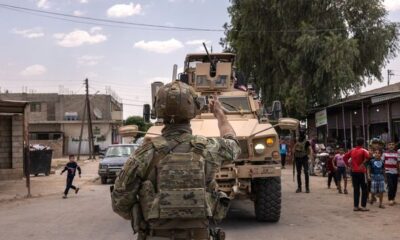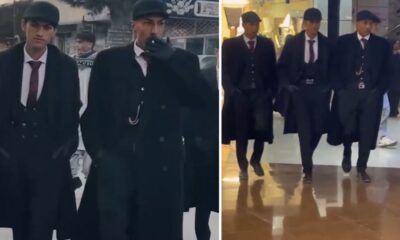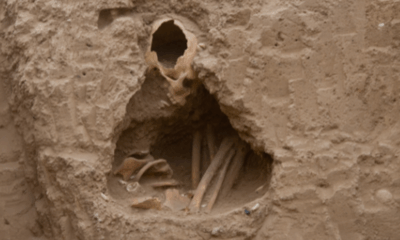World
Youngest Female War Artist Chronicles Afghanistan Experience

At just 26 years old, Charlie Calder-Potts became the youngest female war artist commissioned by the British Army. Her journey to Afghanistan in 2013 began with a fascination for the region, cultivated during her travels through Lebanon and Syria. Eager to explore the complex landscape and history of conflict, she reached out to various Army regiments, expressing her desire to document life on the ground as a war artist.
Receiving an invitation from the 9th/12th Royal Lancers was both thrilling and daunting for Charlie. She recalls her parents’ mixed feelings about her decision to embed with British troops in a country marked by conflict, yet they ultimately supported her adventurous spirit.
After completing a training camp in Dorset, Charlie boarded a Chinook helicopter to Camp Bastion in the Helmand Province, which served as the main hub for British operations. The camp, comparable in size to a small town, had amenities like a Costa Coffee but felt heavily fortified and isolated. “It was very surreal,” Charlie reflects, highlighting the odd juxtaposition of normalcy amidst military tensions.
Upon her arrival, the UK government announced troop withdrawals, leaving many soldiers in a state of limbo. The atmosphere combined danger with monotony, as some soldiers remained on base for months without relief. This backdrop offered Charlie a unique perspective as she engaged with the troops, documenting their lives through photography and sketches.
Her experiences included mine detection training, which allowed her to venture beyond the camp to various bases in the region. Charlie recalls the breathtaking views from helicopter rides, contrasting the beauty of Afghan sunsets with the distant sounds of gunfire. “It was very hard to marry up what was happening when you’re watching a beautiful sunset from an observer tower,” she explains.
Among her most poignant captures was an image of a man with a bouquet of helium balloons, symbolizing hope in a wartime environment. “It was taken from behind barbed wire yet it was such a normal thing,” she notes. This moment encapsulated the stark reality of life in conflict zones, where ordinary people strive for normalcy amidst chaos.
In addition to photography, Charlie utilized salvaged metal from military vehicles to create art that combined her experiences with elements of history. The physical demands of her role were significant; she often felt exhausted from the heat and the weight of her protective gear. At night, she slept in the women’s quarters of the camp, a space that was often shared with numerous male soldiers.
Despite being the only woman among around 100 men on one base, Charlie describes a strong sense of camaraderie. Soldiers frequently opened up to her about their lives, families, and the emotional toll of being away from home. Their stories of longing and care packages from loved ones painted a vivid picture of their sacrifices.
Reflecting on her time in Afghanistan, Charlie acknowledges her initial political reservations about the deployment. Yet, she developed a profound respect for the soldiers who faced the grim realities of war. “You can never understand a situation until you’re in it,” she states, recognizing the risks they took and the bonds they formed.
Charlie’s most alarming moment occurred during her return journey from the capital to Helmand. A quiet tension filled the vehicle as they learned of an intercepted Taliban radio message indicating a suicide bomber was targeting their convoy. “That journey was only half an hour but it felt like forever,” she recalls.
Since her time as a war artist, Charlie has continued to explore conflict zones, including Iraq and Syria. Her recent projects include collaboration with War Child, where she contributed to the Sound & Vision exhibition, inspired by the lyrics of Kate Bush.
Now a mother, Charlie has shifted her focus from war zones to her local environment in Herefordshire, where she forages for materials to create art. She draws inspiration from ancient techniques and aims to connect modern audiences with historical practices. Currently, she is working on a project based on the Tacuinum sanitatis, an 11th-century manuscript on health and well-being.
Charlie’s journey as a war artist reflects not only her adventurous spirit but also the deeper human connections and stories that arise even in the most challenging circumstances. Her commitment to documenting experiences of conflict and resilience continues to inspire her work today.
-

 World5 days ago
World5 days agoCoronation Street’s Shocking Murder Twist Reveals Family Secrets
-

 Entertainment4 months ago
Entertainment4 months agoKate Garraway Sells £2 Million Home Amid Financial Struggles
-

 Entertainment3 months ago
Entertainment3 months agoAnn Ming Reflects on ITV’s ‘I Fought the Law’ Drama
-

 Entertainment3 days ago
Entertainment3 days agoAndrew Pierce Confirms Departure from ITV’s Good Morning Britain
-

 Health3 months ago
Health3 months agoKatie Price Faces New Health Concerns After Cancer Symptoms Resurface
-

 Entertainment4 weeks ago
Entertainment4 weeks agoCoronation Street Fans React as Todd Faces Heartbreaking Choice
-

 World4 weeks ago
World4 weeks agoBailey Announces Heartbreaking Split from Rebecca After Reunion
-

 Entertainment1 week ago
Entertainment1 week agoTwo Stars Evicted from I’m A Celebrity Just Days Before Finale
-

 World1 week ago
World1 week agoKevin Sinfield Exceeds Fundraising Goal Ahead of Final Marathons
-

 Entertainment3 months ago
Entertainment3 months agoCoronation Street’s Carl Webster Faces Trouble with New Affairs
-

 Entertainment3 months ago
Entertainment3 months agoWhere is Tinder Swindler Simon Leviev? Latest Updates Revealed
-

 Entertainment4 months ago
Entertainment4 months agoMarkiplier Addresses AI Controversy During Livestream Response





















